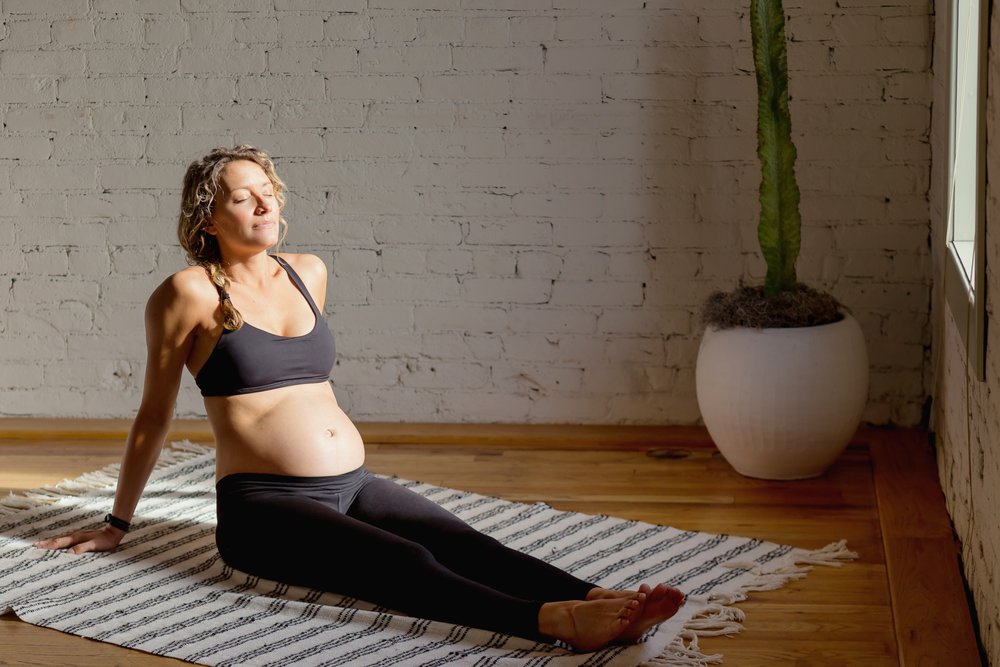The Truth About Lying on Your Back During Pregnancy
Keep building core strength during pregnancy with these modifications and tips for common back exercises.

One of the more well-known and pervasive pieces of advice for women during pregnancy is that they shouldn’t sleep or exercise on their back. Even though the research isn’t definitive on the topic and advice often varies about WHEN to stop lying on your back, the consensus seems to be “better safe than sorry.”
At Bloom, we are all about myth-busting. All too often, we find this type of “do or don’t” advice ignores nuance and fails to properly educate women about what’s actually happening in their bodies. Like most things in life, when it comes to lying on your back during sleep or exercise, there’s a big gray area.
There are lots of benefits to back exercises, with low-impact options for building glute and core strength during pregnancy. By tuning into your intuition and what feels good in your body, you can keep back exercises in your arsenal. If needed there are many options for modifications to make exercising on your back more comfortable.
What Happens When You Lie On Your Back During Pregnancy
The reason that doctors discourage back-sleeping in particular is because when you lie on your back, the weight of your growing uterus and baby press on the vena cava - aka the main vein that carries blood back to the heart from your lower body.
This pressure can reduce blood flow, which means less oxygen for you and your baby. Less oxygen in your blood also causes poor circulation (leading to swollen feet or ankles), low blood pressure, and makes you dizzy when you stand up. While you MAY experience these side-effects, it’s entirely possible you won’t have a problem at all.
There are a variety of criteria to consider when it comes to whether or not to lie on your back while pregnant.
How far along are you? The most recent advice discourages sleeping on your back after the third trimester. Specifically, doctors advise against going to sleep on your back. This does not include waking up on your back in the middle of the night. If you wake up on your back, simply change positions, get comfortable again, and *hopefully* drift off to sleep again.
Are you carrying twins? The increased weight from two babies may mean you want to adjust your sleep/exercise routine a bit earlier than usual, but talk to your practitioner and trust your instinct on this.
Exercising on your back is not the same as sleeping on your back. A few reps of bridge pose will have you on your back for a few minutes. It’s unlikely you’ll have a problem in that amount of time, as long as you roll onto your side to sit up and stand up slowly.
How much time are you spending on your back? The study that is most often cited when it comes to the possible link between stillbirth and back sleeping comes out of New Zealand. In this study, women went to sleep lying on their backs and didn’t get up all night. This is an extremely unlikely scenario (and there are additional issues with this study) as most people shift positions throughout the night, and most pregnant women get up to pee during the night.
How does your body respond to lying on your back? Some women have no problem at all lying on their back for a few minutes during exercise. Other women find that they get uncomfortable immediately. You should do what feels best for your body.
Depending on how far along you are, the pressure from your growing baby can also aggravate backaches and hemorrhoids and make digestion less efficient. If you experience adverse effects, you can always modify the exercises with the tips we’ve outlined below.
Exercising On Your Back During Pregnancy
Many articles on prenatal exercise advise mamas to avoid back exercises altogether and make yet another unnecessary sacrifice in the name of pregnancy. But the rationale that “it’s just for 9 months” or “they’ll be there for you after the baby is born” doesn’t really hold up against science.
It is true that the combination of your organs repositioning during pregnancy and the added weight of the baby put additional pressure on the vena cava when you lie on your back, especially during the third trimester. However, one of the key factors to consider is how much time you're spending on your back.
Glute bridges, chest presses or popular yoga poses like happy baby only require you to lie on your back for one to two minutes. For most women this short amount of time won’t cause any problems. If you do get dizzy, many back exercises are easy to modify with pillows or an inclined position.
Just like completely giving up caffeine or fish during pregnancy isn’t necessary, if you enjoy back exercises and you aren’t experiencing any problems, then likely it’s safe to continue doing these the entirety of your pregnancy. Of course if you have any questions or other hesitations, talk to your healthcare provider.
Five Ways to Modify Common Back Exercises During Pregnancy

Continuing to strengthen your core during pregnancy is crucial for supporting your pelvic floor, avoiding low back pain, and even empowering you during the pushing phase of labor. If you find that even lying on your back for a short period of time causes problems, don’t give up on back exercises entirely.
Most ab and glute exercises are easily modified with the assistance of props, or even just your arms. Here are four ideas for modifying your favorite back exercises during pregnancy:
Use your forearms to prop yourself up during toe taps or leg lifts.
Lean on a foam roller or wedge, creating a slight incline in your upper body.
Prop yourself up on a couple of pillows.
A swiss ball can support you during side stretches (like supported side angle) and even during seated exercises like spinal circles.
Use a chair or workout bench with extra risers on one side to create a reclined position for exercises like chest presses.
Especially during pregnancy, it’s important to warm up before working out to avoid injury and make sure you’re properly connecting to and engaging your core. As your belly grows during pregnancy, being able to tap into your deep core is critical for safe and effective exercise, but it can also be tricky! So spending a few minutes practicing can really help reinforce that connection.
Bottom Line:
While it’s true that the combination of your growing uterus and baby creates additional pressure on the vena cava when you lie on your back during pregnancy, there’s a lot of gray area that’s often overlooked when giving mamas advice about sleep and exercise.
Especially when it comes to exercise, most of the popular glute, core and yoga moves that have you on your back only last a few minutes. Many women will have no problem at all with being on their backs for this short amount of time. However, if you do experience discomfort or dizziness, it’s easy to modify most of these moves with props.
So don’t write off back exercises entirely during pregnancy. Many of these moves are safe and effective ways to strengthen your core and glutes while pregnant, or even to provide some relief to your low back, hips and side body. And if you want more guidance, inside Studio Bloom we have dozens of safe and effective core workouts for pregnant mamas.




